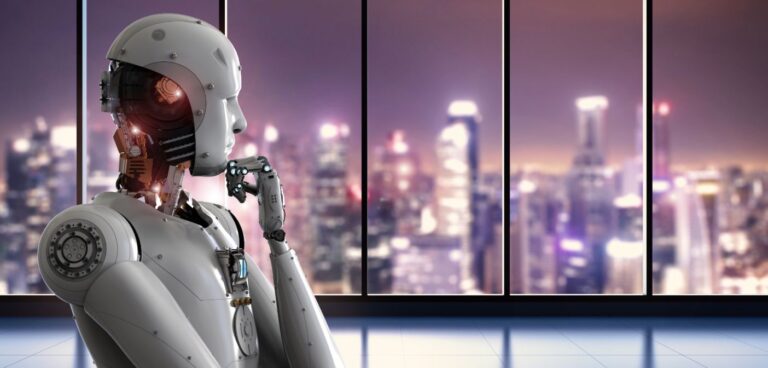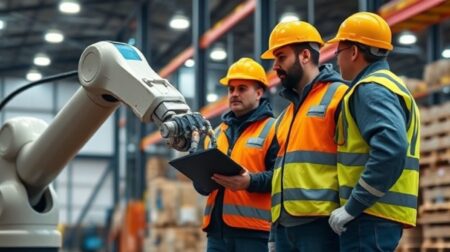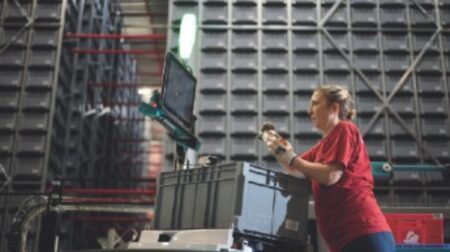Held via Swapcard on 23 – 24 June, the inaugural Robotics & Innovation conference brought together the brightest minds from across the global robotics value chain for two days of presentations, discussion and an exclusive first live demonstration…
The first-ever Robotics & Innovation Conference was held virtually this June with speakers logging in from the bottom of their gardens, dialling in from the U.S, India, Malaysia and even on the road to provide invaluable insights into how cutting-edge robotics, AI and state-of-the-art technologies are transforming industries around the world.
Across the two days perceptive presentations, case studies and engaging panel discussions were delivered by some of the biggest names developing and utilising robotic solutions today.
What’s more, Industrial Cleaning Equipment (ICE), a provider of autonomous cleaning robots to the likes of London Luton Airport joined the event as its first official sponsor.
Day One kicked off with Jonathan Smith, head of development at Three, who ensured viewers that the adoption of robotics in telco was more Pixar’s WALL-E than Schwarzenegger’s Terminator. He explained that previous concerns centred around job roles being replaced by robotics resulting in “powerful emotions” from workers across various sectors. Smith added there has since been a cultural shift as businesses discovered the real value of robotics is collaboration and co-production. Smith said: “If you can show the people the future of work – they can become the developers.”
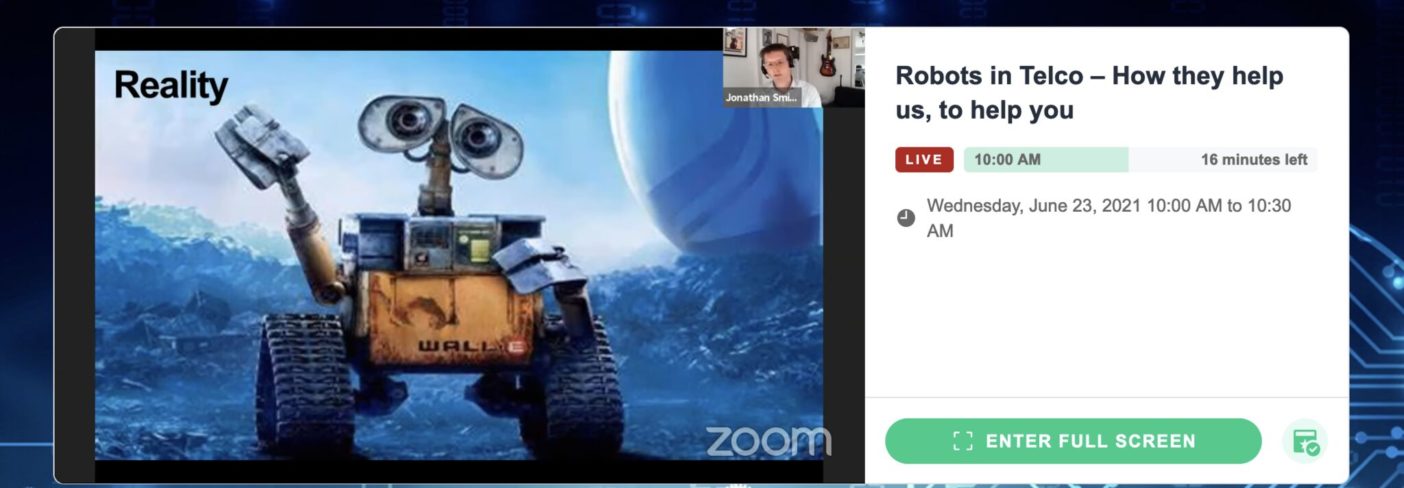
He advises companies start small, control aspirations from the beginning and take a “Field of Dreams” approach to automation. Smith recommended companies “build it and they will come”, through constant demonstration of any innovative idea to its team, businesses will not have to hard-sell the solution and in fact find people coming to them with further opportunities.
For Ricky Smith, head of sales and innovation at ICE it was less about protecting jobs roles and more a case of robots filling the labour shortages created by the current climate – both Covid-19 and Brexit creating a “step change”. As the first company to provide a comprehensive range of autonomous floor cleaning machines, ICE’s presentation focused on the shifting perception of hygiene and how a robotic solution provides unparalleled cleaning of public environments such as hospitals, rail stations, offices and within retail spaces.
Following the morning networking break, Rav Chunilal, head of robotics and artificial intelligence at Sellafield looked at robotic technology for hazardous environments, particularly nuclear sites. Chunilal provided an overview of the testing and trialling of robotic and AI systems used to protect workers in highly radioactive environments at the Cumbria site. He explained while currently the use of such technology is very much the “art of the possible” he hopes one day these solutions will become “business as normal” with the use of robots talked about routinely.
Also looking to the future was Tony Young, national clinical lead for innovation at NHS England. Young spoke passionately and with pride explaining that the NHS is world leading in how it embraces technology. More than just explaining its vision for the future and the work its Clinical Entrepreneur Programme does, Young was able to provide the first live demonstration of an AI-powered learning tool used to train doctors through immersive patient simulations. The simulated encounter with ‘Sabine’ showcased the ability to engage with patient avatars to diagnose a range of conditions.
He concluded it is through such innovative tools that the NHS is not only able to support its workforce but also empower it. During the Q&A section Young stressed that any technology installed within the NHS will always put the patients first. He said: “Patients need to be involved in every step along the way, in all we do, every application, has to have patient and public involvement.”
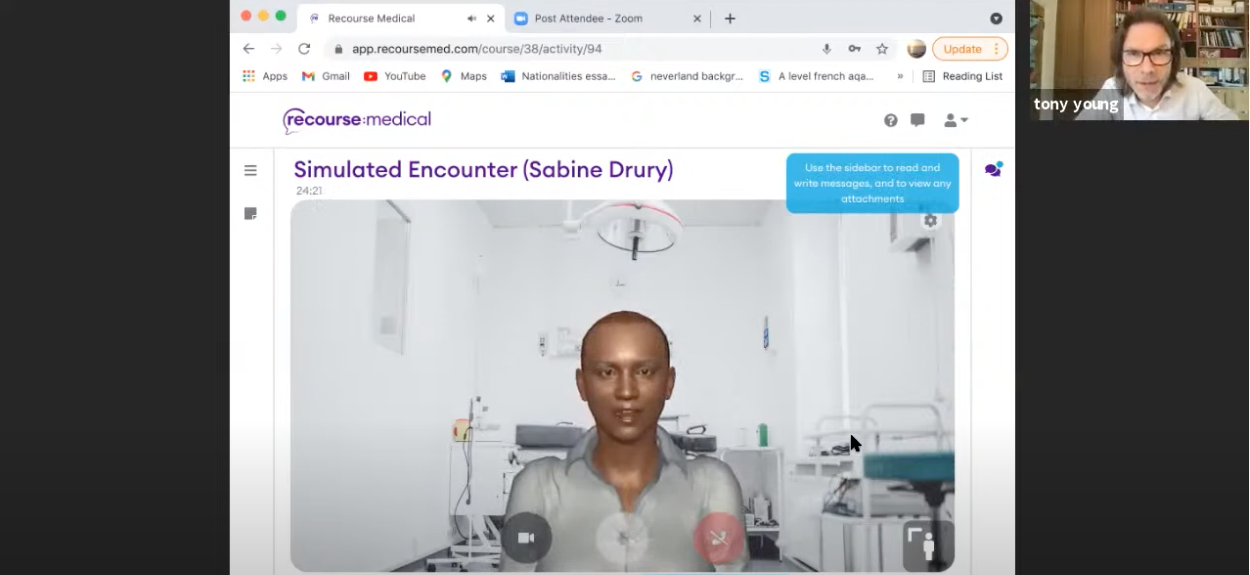
Opening the afternoon session was Yvan Petillot, co-academic lead of the National Robotarium based at Heriot-Watt University, Edinburgh. He looked at how academia plays a leading role in developing innovation in industry and highlighted some of the benefits and pitfalls of working with academia. Petillot explained: “Doing research is great, it is interesting, but it is best when moved into practical applications.”
He was able to provide examples of past and current projects in marine environments and a case study of its work on Total’s Shetland gas plant.
This led seamlessly into the next presentation from Aneesh Chand, head of robotics at Petronas who covered the use of inspection and maintenance robots in the energy industry. Featuring a number of videos Chand’s slides showcased the use of robots for inspection, maintenance and process optimisation on oil rigs. As well as providing insight into its development of delivery drones.
Back for more
The second day of this virtual conference provided further insight from unique organisations starting with the UK Space Agency. Catherine Mealing-Jones and Dan Jones took the audience through the cross pollination of technologies for our journey to space. While working in space may be an extraordinary environment, the goals and aims were similar to other industries. The UK Space Agency like many others is striving to use robots to ensure sustainable growth, to guarantee the systems they create limit “the junk up in space” and the autonomous solutions developed foster a strong and competitive sector.
Environmental impact was also at the forefront of the next speaker’s presentation as Captain Georgina Carlo-Paat, Ilfracombe harbour master explained how WasteShark reduces marine pollution. Featuring stunning images from the Devon harbour, Carlo-Paat described the overwhelming community support for the use of an autonomous water vehicle to remove plastics, such as crisp packets, from the harbour.
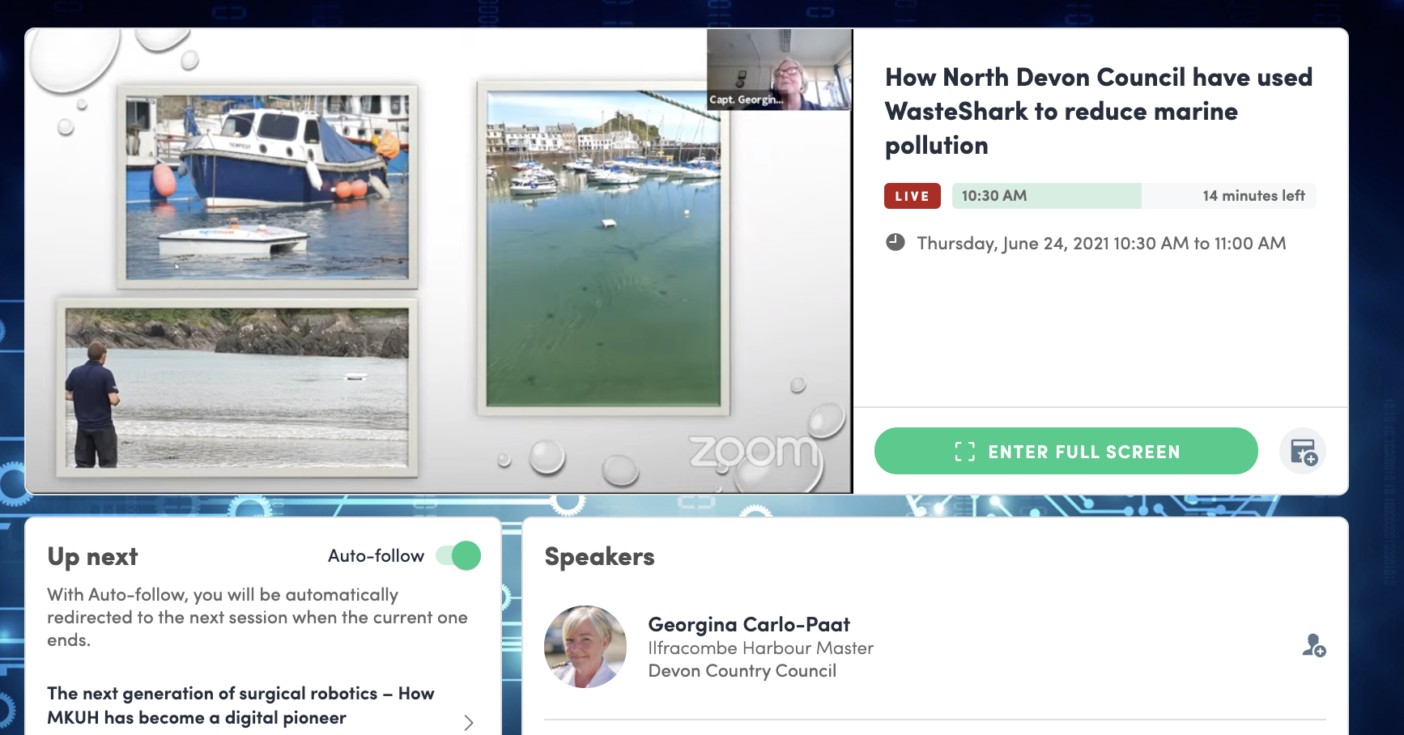
Prior to lunch, Professor Joe Harrison from Milton Keynes University Hospital NHS Foundation Trust also provided a positive engagement study revealing that nine out of 10 patients want to be involved in research involving the next generation of surgical robots.
Harrison explained that while the MKUH has a low-risk appetite to limit issues in patient surgery it is also becoming a digital pioneer to ensure the best possible outcomes for both its surgeons and the people in its care.
The afternoon sessions also looked at reducing risks with an important safety presentation from Bob Bollinger, technical director of applied robotics innovation at Proctor & Gamble who looked at the pitfalls of collaborative robotics.
Dialling in from Ohio, Bollinger reviewed what more can be done to ensure the safe operation of cobot interaction with human operators.
And last but by no means least, Jay Newton, HS1 head of stations engineering and operations, described how the installation of a digital twin, the use of data and cleaning robots has enabled HS1 to put its customers first. Newton explained the data provided from the digital twin enables HS1 to provide “clean, clear understanding to the customer. It gives the customer confidence that we know what is going to happen and we are planning for what is going to happen.”
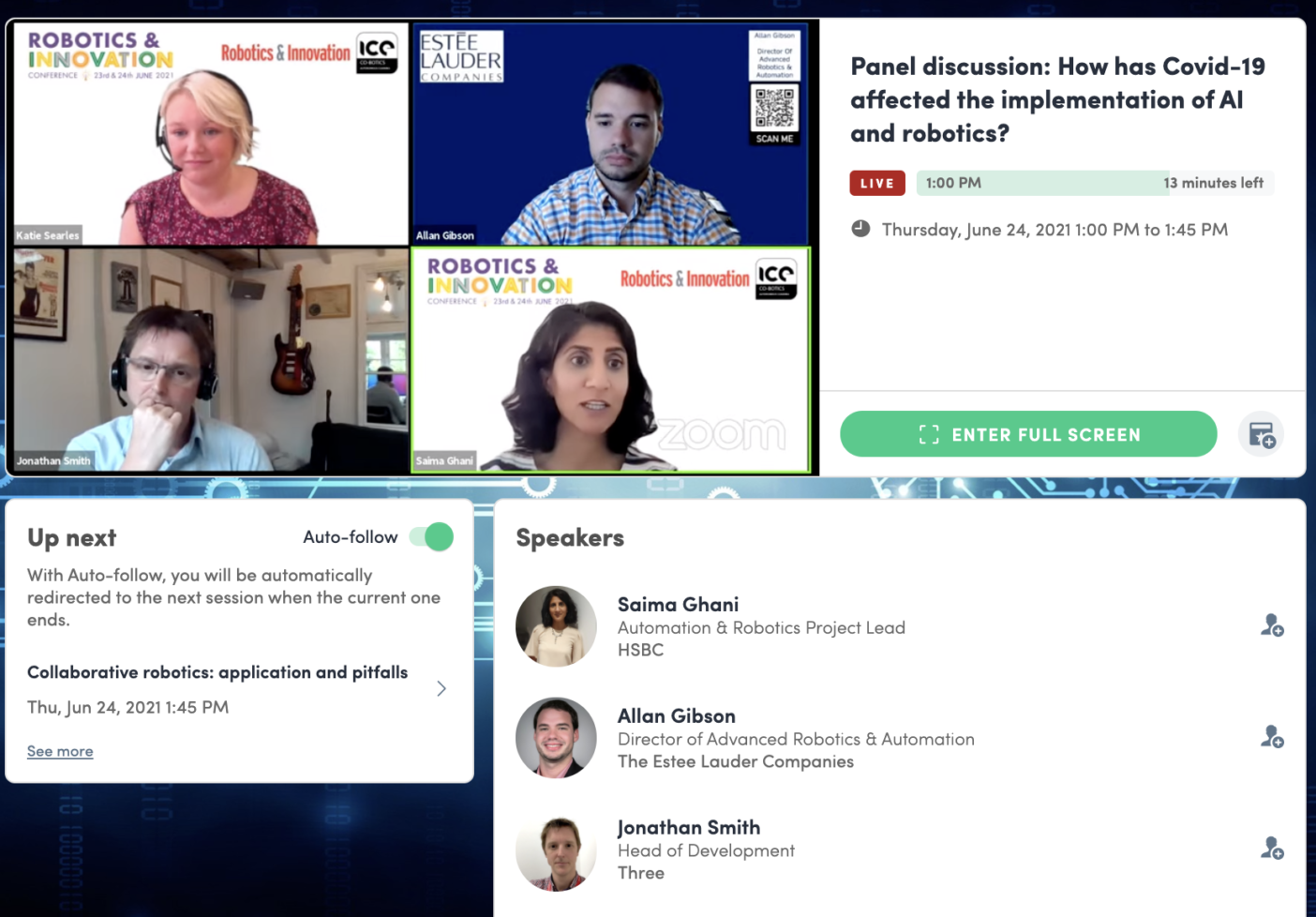
Time to Talk
Alongside the individual presentations, Robotics & Innovation Conference also brought together experts from different industries to discuss hot technology topics during two panel discussions.
While each business had individual approaches, challenges and ideas about deploying technology these specialists were able to share experiences and knowledge on a future world run by innovative robotics and the impact of Covid-19.
During the first panel Marco Chacin, robotics, autonomous systems, factory automation and motion control specialist at Airbus, Allan Gibson, director of advanced robotics and automation at the Estee Lauder Companies and Prateek Kapoor, director of automation & innovation COE at Aon discussed the need for – or lack of – standardisation in robotics. Each speaker had varying priorities whether that was using robots to ensure quality, to assist with labour shortages or provide agile systems to keep up with customer demand. They all agreed that going forward more and more businesses and industries will be looking at automation and robots to work more effectively and efficiently.
Additionally, the panel discussion on day two saw Allan Gibson return to be joined by Jon Smith, head of development at three, and Saima Ghani, Senior project manager of HSBC to look at how Covid-19 has affected the implementation of AI and robotics.
Each speaker provided examples of how the manufacturing, telco and financial sectors have harnesses new technical solutions to limit the impact of the pandemic. And how in the past 18-months their sectors have adapted to new ways of working.

